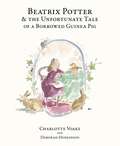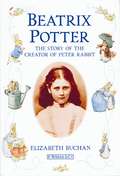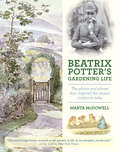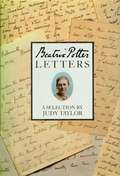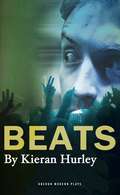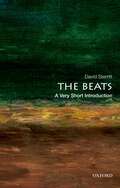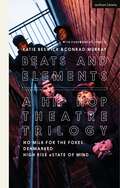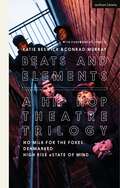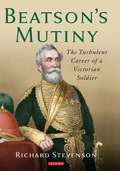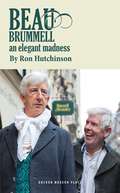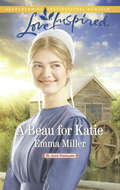- Table View
- List View
Beatrix Potter and the Unfortunate Tale of the Guinea Pig
by Deborah Hopkinson Charlotte VoakeYoung Beatrix Potter loves to draw animals. She has many pets whom she likes to paint - a frog, a salamander, a canary and even a hedgehog. But she doesn't have a guinea pig so she borrows her neighbour's, promising that no harm will come to the cuddly creature. After all, what could possibly go wrong...?This hilarious and charming new book is based on Beatrix Potter's own diary entries, and is perfect for Potter fans young and old.
Beatrix Potter Artist, Storyteller and Countrywoman: Artist, Storyteller, And Countrywoman
by Judy TaylorStarting with the publication of The Tale of Peter Rabbit in 1902, Beatrix Potter went on to become one of the world's most successful children's authors. This illustrated biographical eBook takes the reader through the whole of her life, from her Victorian childhood in London to her final years farming in the Lake District. Regarded as a standard work on Beatrix Potter's life, this work has been updated regularly to include fresh material and previously unpublished photographs that have come to light as interest in Beatrix Potter continues to grow.
Beatrix Potter The Story of the Creator of Peter Rabbit: The Story Of The Creator Of Peter Rabbit
by Beatrix Potter Elizabeth Buchan Mike DoddThis simplified biographical eBook of Beatrix Potter and the history of the Peter Rabbit book is ideal for the younger reader.
Beatrix Potter's Countryside
by Linda Elovitz MarshallBeatrix Potter created one of the world's most enduring characters and found inspiration in the world of nature. Her global success allowed her to protect and conserve her beloved Lake District home from.This beautifully illustrated picture book tells the story of Beatrix's life and the countryside she cherished.
Beatrix Potter's Gardening Life: The Plants and Places That Inspired the Classic Children's Tales
by Marta McDowellRichly illustrated and filled with quotations from her books, letters, and journals, Beatrix Potter's Gardening Life is essential reading for all who know and cherish Beatrix Potter and her classic tales.
Beatrix Potter's Journal
by Beatrix PotterBetween the ages of 15 and 30 Beatrix Potter kept a secret diary written in code. When the code was cracked by Leslie Linder more than 20 years after her death, the diary revealed a remarkable picture of upper middle-class life in late Victorian Britain. The original diaries run to over 200,000 words so for this edition Glen Cavaliero has made a careful selection of complete entries and excerpts which provide an illuminating insight into the personality and inspiration of one of the world's best loved children's authors.
Beatrix Potter's Letters: Selected Letters
by Beatrix Potter Judy TaylorBeatrix Potter was a very private person, yet, luckily for us, she was a prolific letter writer. Through her own words to friends, working colleagues and children we can discover the observant, energetic, affectionate and humorous personality she kept hidden from her public. Her life covers a period of immense social change. The restricted existence of a dutiful Victorian daughter, the background against which she first wrote the story of Peter Rabbit, was very different from that of war-time England where she continued to pioneer countryside conservation until her death.
Beatriz Allende: A Revolutionary Life in Cold War Latin America
by Tanya HarmerThis biography of Beatriz Allende (1942–1977)—revolutionary doctor and daughter of Chile's socialist president, Salvador Allende—portrays what it means to live, love, and fight for change. Inspired by the Cuban Revolution, Beatriz and her generation drove political campaigns, university reform, public health programs, internationalist guerrilla insurgencies, and government strategies. Centering Beatriz's life within the global contours of the Cold War era, Tanya Harmer exposes the promises and paradoxes of the revolutionary wave that swept through Latin America in the long 1960s.Drawing on exclusive access to Beatriz's private papers, as well as firsthand interviews, Harmer connects the private and political as she reveals the human dimensions of radical upheaval. Exiled to Havana after Chile's right-wing military coup, Beatriz worked tirelessly to oppose dictatorship back home. Harmer's interviews make vivid the terrible consequences of the coup for the Chilean Left, the realities of everyday life in Havana, and the unceasing demands of solidarity work that drained Beatriz and her generation of the dreams they once had. Her story demolishes the myth that women were simply extras in the story of Latin America's Left and brings home the immense cost of a revolutionary moment's demise.
The Beats: A Teaching Companion (Clemson University Press: Beat Studies)
by Nancy GraceThis volume addresses integrating into the classroom Beat authors, texts, and themes associated with Beat writing, generally dated from the early 1950s to 1964-65, when the major social justice movements in the United States began to tear apart the fabric of post war containment culture and Hippie counterculture became a dominant movement. The book provides a robust foundation for discussions of the continued relevance of Beat literature in educational settings. The volume’s 22 essays are divided into six domains: 1) Foundational Issues, 2) Beat Literary Genres, 3) Beat Literary Topics, 4) Beat Lineages and Legacies, 5) Selected Resources, and 6) Sample Assignments. The volume presents a blending of authors and subject matters representative of current styles and methods of Beat scholarship. Literature-focused pedagogies dominate, but course materials and perspectives relative to history, composition theory and practice, religious studies, art history, film studies, and other cross-curricular courses are also represented. The sequencing of each part is hierarchical only in the sense that Part 1 is intended to be read first, since topics in that section speak to key practices and traditions undergirding Beat history and the teaching of Beat writing in general. The volume concludes with sample classroom assignments and examination prompts by Beat scholars.
Beats (Oberon Modern Plays)
by Kieran HurleyIn 1994 the Criminal Justice Act effectively outlawed raves, banning public gatherings around amplified music characterised by ‘the emission of a succession of repetitive beats.’Featuring a soundtrack from a live DJ and psychedelic 90s-inspired visuals, Beats tells the story of Johnno McCreadie, a teenager living in a small suburban Scottish town at the time of the Act. Beats is an award-winning new play by Kieran Hurley; a coming-of-age story exploring rebellion, apathy, and the irresistible power of gathered youth.Beats was the winner of CATS Best New Play Award 2012
The Beats: A Very Short Introduction (Very Short Introductions)
by David SterrittIn the late 1950s and early 1960s, the writers of the Beat Generation revolutionized American literature with their iconoclastic approach to language and their angry assault on the conformity and conservatism of postwar society. They and their followers took aim at the hypocrisy and taboos of their time--particularly those involving sex, race, and class--in such provocative works as Jack Kerouac's On the Road (1957), Allen Ginsberg's "Howl" (1956), and William S. Burroughs's Naked Lunch (1959). In this Very Short Introduction, David Sterritt offers a concise overview of the social, cultural, and aesthetic sensibilities of the Beats, bringing out the similarities that connected them and also the many differences that made them a loosely knit collective rather than an organized movement. Figures in the saga include Neal Cassady, Gregory Corso, Lawrence Ferlinghetti, John Clellon Holmes, Carolyn Cassady, and Gary Snyder. As Sterritt ranges from Greenwich Village and San Francisco to Mexico, western Europe, and North Africa, he sheds much light on how the Beats approached literature, drugs, sexuality, art, music, and religion. Members of the Beat Generation hoped that their radical rejection of materialism, consumerism, and regimentation would inspire others to purify their lives and souls as well. Yet they urged the remaking of consciousness on a profoundly inward-looking basis, cultivating "the unspeakable visions of the individual," in Kerouac's phrase. The idea was to revolutionize society by revolutionizing thought, not the other way around. This book explains how the Beats used their antiauthoritarian visions and radical styles to challenge dominant values, fending off absorption into mainstream culture while preparing ground for the larger, more explosive social upheavals of the 1960s. More than half a century later, the Beats' impact can still be felt in literature, cinema, music, theater, and the visual arts. This compact introduction explains why. About the Series: Oxford's Very Short Introductions series offers concise and original introductions to a wide range of subjects--from Islam to Sociology, Politics to Classics, Literary Theory to History, and Archaeology to the Bible. Not simply a textbook of definitions, each volume in this series provides trenchant and provocative--yet always balanced and complete--discussions of the central issues in a given discipline or field. Every Very Short Introduction gives a readable evolution of the subject in question, demonstrating how the subject has developed and how it has influenced society. Eventually, the series will encompass every major academic discipline, offering all students an accessible and abundant reference library. Whatever the area of study that one deems important or appealing, whatever the topic that fascinates the general reader, the Very Short Introductions series has a handy and affordable guide that will likely prove indispensable.
The Beats: A Very Short Introduction (Very Short Introductions)
by David SterrittIn the late 1950s and early 1960s, the writers of the Beat Generation revolutionized American literature with their iconoclastic approach to language and their angry assault on the conformity and conservatism of postwar society. They and their followers took aim at the hypocrisy and taboos of their time--particularly those involving sex, race, and class--in such provocative works as Jack Kerouac's On the Road (1957), Allen Ginsberg's "Howl" (1956), and William S. Burroughs's Naked Lunch (1959). In this Very Short Introduction, David Sterritt offers a concise overview of the social, cultural, and aesthetic sensibilities of the Beats, bringing out the similarities that connected them and also the many differences that made them a loosely knit collective rather than an organized movement. Figures in the saga include Neal Cassady, Gregory Corso, Lawrence Ferlinghetti, John Clellon Holmes, Carolyn Cassady, and Gary Snyder. As Sterritt ranges from Greenwich Village and San Francisco to Mexico, western Europe, and North Africa, he sheds much light on how the Beats approached literature, drugs, sexuality, art, music, and religion. Members of the Beat Generation hoped that their radical rejection of materialism, consumerism, and regimentation would inspire others to purify their lives and souls as well. Yet they urged the remaking of consciousness on a profoundly inward-looking basis, cultivating "the unspeakable visions of the individual," in Kerouac's phrase. The idea was to revolutionize society by revolutionizing thought, not the other way around. This book explains how the Beats used their antiauthoritarian visions and radical styles to challenge dominant values, fending off absorption into mainstream culture while preparing ground for the larger, more explosive social upheavals of the 1960s. More than half a century later, the Beats' impact can still be felt in literature, cinema, music, theater, and the visual arts. This compact introduction explains why. About the Series: Oxford's Very Short Introductions series offers concise and original introductions to a wide range of subjects--from Islam to Sociology, Politics to Classics, Literary Theory to History, and Archaeology to the Bible. Not simply a textbook of definitions, each volume in this series provides trenchant and provocative--yet always balanced and complete--discussions of the central issues in a given discipline or field. Every Very Short Introduction gives a readable evolution of the subject in question, demonstrating how the subject has developed and how it has influenced society. Eventually, the series will encompass every major academic discipline, offering all students an accessible and abundant reference library. Whatever the area of study that one deems important or appealing, whatever the topic that fascinates the general reader, the Very Short Introductions series has a handy and affordable guide that will likely prove indispensable.
Beats and Elements: No Milk for the Foxes; DenMarked; High Rise eState of Mind
by Conrad MurrayThis collection of three hip hop plays by Conrad Murray and his Beats & Elements collaborators Paul Cree, David Bonnick Junior and Lakeisha Lynch-Stevens, is the first publication of the critically acclaimed theatre-maker's work. The three plays use hip hop to highlight the inequalities produced by the UK's class system, and weave lyricism, musicality and dialogue to offer authentic accounts of inner-city life written by working-class Londoners. The plays are accompanied by two introductory essays: The first gives a specific social and historical context that helps readers make sense of the plays, the second positions hip hop as a contemporary literary form and offers some ways to read hip hop texts as literature. The collection also includes a foreword by leading hip hop theatre practitioner Jonzi D, interviews with the Beats & Elements company, and a glossary of words for students and international readers.
Beats and Elements: No Milk for the Foxes; DenMarked; High Rise eState of Mind
by Conrad MurrayThis collection of three hip hop plays by Conrad Murray and his Beats & Elements collaborators Paul Cree, David Bonnick Junior and Lakeisha Lynch-Stevens, is the first publication of the critically acclaimed theatre-maker's work. The three plays use hip hop to highlight the inequalities produced by the UK's class system, and weave lyricism, musicality and dialogue to offer authentic accounts of inner-city life written by working-class Londoners. The plays are accompanied by two introductory essays: The first gives a specific social and historical context that helps readers make sense of the plays, the second positions hip hop as a contemporary literary form and offers some ways to read hip hop texts as literature. The collection also includes a foreword by leading hip hop theatre practitioner Jonzi D, interviews with the Beats & Elements company, and a glossary of words for students and international readers.
The Beats and the Academy: A Renegotiation (Clemson University Press: Beat Studies)
The Beats and the Academy marks the first sustained effort to train a scholarly eye on the dynamics of the relationship between Beat writers and the academic institutions in which they taught. Rather than assuming the relationship between Beat writers and institutions of higher education was only a hostile one, The Beats and the Academy begins with the premise that influence between the two flows in both directions. Beat writers' suspicion of established institutions was a significant aspect of their postwar countercultural allure. Their anti-establishment aesthetic and countercultural stance led Beat writers to be critical of postwar academic institutions that tended to dismiss them as a passing social phenomenon. Even today, Beat writing still meets resistance in an academy that questions the relevance of their writing and ideas. But this picture, like any generalization, is far too easy. The Beat relationship to the academy is one of negotiation, rather than negation. Many Beats strove for academic recognition, and quite a few received it. And despite hostility to their work both in the postwar era and today, Beat works have made it into syllabi, conference resentations, journal articles, and monographs. The Beats and the Academy deepens our understanding of this relationship by emphasizing how institutional friction between the Beats and institutions of higher education has shaped our understanding of Beat Generation literature and culture—and what this relationship between Beat writers and the academy might suggest about their legacy for future scholars.
The Beats, Black Mountain, and New Modes in American Poetry (Clemson University Press: Beat Studies)
The Beats, Black Mountain, and New Modes of American Poetry explores correspondences amongst the Black Mountain and Beat Generation writers, two of most well-known and influential groups of poets in the 1950s. The division of writers as Beat or Black Mountain has hindered our understanding of the ways that these poets developed from mutual influences, benefitted from direct relations, and overlapped their boundaries. This collection of academic essays refines and adds context to Beat Studies and Black Mountain Studies by investigating the groups’ intersections and undercurrents. One goal of the book is to deconstruct the Beat and Black Mountain labels in order to reveal the shifting and fluid relationships among the individual poets who developed a revolutionary poetics in the 1950s and beyond. Taken together, these essays clarify the radical experimentation with poetics undertaken by these poets.
Beatson's Mutiny: The Turbulent Career of a Victorian Soldier
by Richard StevensonOver a long and varied career, Major-General William Beatson earned a fine reputation as a leader of irregular cavalry in the nineteenth century. He trained many future commanders of the Victorian army, saw action in Spain and British India, and rode with the Heavy Brigade at the Battle of Balaklava. But tasked with disciplining the Turkish Bashi-Bazouks during the Crimean War, his character flaws led him into conflict with politicians and diplomats running the war, who accused him of inciting mutiny. Parliament, newspapers and the law courts then became his chosen battlefields as he fought to clear his name and return to duty. By bringing Beatson's life and career into sharper focus, Richard Stevenson connects wide-ranging themes in Victorian military and imperial history in a fresh and accessible way.
Beau: In A Cowboy's Arms Beau: Cowboy Protector (Harts of the Rodeo #5)
by Marin ThomasThe Heart Of The Matter Beau Adams should be focused on getting himself and Midnight, the Harts' prized stallion, to the National Finals Rodeo, but he can’t stop thinking about the feisty Sierra Byrne. They have an electric connection, and Beau hopes it's the beginning of something more.
Beau Brummel: an elegant madness (Oberon Modern Plays)
by Ron HutchinsonIt is the winter of 1819. The most famous wit and dandy of them all, the man who taught a generation of Englishmen how to dress, friend and confidant to lords, ladies and royalty, is preparing to receive the Prince of Wales. But this is not Bath or Brighton or any of the other fashionable watering holes where for years Beau Brummell held court to regency swells. The most stylish man of his day now lives in a madhouse in Calais with his valet, determined as ever to relive past glories. Beau Brummell had its world premiere at the Theatre Royal, Bath in February 2001, and starred Peter Bowles.
Beau Death (Peter Diamond Mystery #17)
by Peter LoveseyA wrecking ball crashes through the roof of a terraced cottage in Bath and exposes a skeleton in eighteenth-century clothes. Can these possibly be the remains of Beau Nash, the so-called King of Bath, whose body is said to have ended up in a pauper's grave?Peter Diamond, the city's most experienced detective, is ordered to investigate, but grappling with historical events causes ructions in his team until everyone is diverted by a modern killing during a fireworks display on the Royal Crescent lawn.But Beau Nash refusesto be ignored - and when astonishing new facts emerge about the case, Bath's history is rewritten and mysteries ancient and modern are fused in a devastating climax.
A Beau For Katie: A Beau For Katie (The Amish Matchmaker #3)
by Emma MillerThe Housekeeper's Surprise Match
The Beau Monde: Fashionable Society in Georgian London
by Hannah GreigThe story of the world's first fashion-obsessed society in 18th-century London Caricatured for extravagance, vanity, glamorous celebrity and, all too often, embroiled in scandal and gossip, 18th-century London's fashionable society had a well-deserved reputation for frivolity. But to be fashionable in 1700s London meant more than simply being well dressed. Fashion denoted membership of a new type of society—the beau monde, a world where status was no longer determined by coronets and countryseats alone but by the more nebulous qualification of metropolitan 'fashion'. Conspicuous consumption and display were crucial; the right address, the right dinner guests, the right possessions, the right jewels, the right seat at the opera. The Beau Monde leads us on a tour of this exciting new world, from court and parliament to London's parks, pleasure grounds, and private homes. From brash displays of diamond jewellery to the subtle complexities of political intrigue, we see how membership of the new elite was won, maintained—and sometimes lost. On the way, we meet a rich and colourful cast of characters, from the newly ennobled peer learning the ropes and the imposter trying to gain entry by means of clever fakery, to the exile banned for sexual indiscretion. Above all, as the story unfolds, we learn that being a Fashionable was about far more than simply being 'modish'. By the end of the century, it had become nothing less than the key to power and exclusivity in a changed world.
The Beau Monde: Fashionable Society in Georgian London
by Hannah GreigThe story of the world's first fashion-obsessed society in 18th-century London Caricatured for extravagance, vanity, glamorous celebrity and, all too often, embroiled in scandal and gossip, 18th-century London's fashionable society had a well-deserved reputation for frivolity. But to be fashionable in 1700s London meant more than simply being well dressed. Fashion denoted membership of a new type of society—the beau monde, a world where status was no longer determined by coronets and countryseats alone but by the more nebulous qualification of metropolitan 'fashion'. Conspicuous consumption and display were crucial; the right address, the right dinner guests, the right possessions, the right jewels, the right seat at the opera. The Beau Monde leads us on a tour of this exciting new world, from court and parliament to London's parks, pleasure grounds, and private homes. From brash displays of diamond jewellery to the subtle complexities of political intrigue, we see how membership of the new elite was won, maintained—and sometimes lost. On the way, we meet a rich and colourful cast of characters, from the newly ennobled peer learning the ropes and the imposter trying to gain entry by means of clever fakery, to the exile banned for sexual indiscretion. Above all, as the story unfolds, we learn that being a Fashionable was about far more than simply being 'modish'. By the end of the century, it had become nothing less than the key to power and exclusivity in a changed world.
Beauchamp Hall: A Novel
by Danielle SteelAn uplifting, inspiring story about taking control of your life, by the world’s favourite storyteller, Danielle Steel.Winona Farmington can’t help but feel that life is passing her by in her backwater Michigan town. She hates her job, and her boyfriend won’t commit. But she escapes the dreariness of everyday life with her favourite TV show, Beauchamp Hall, an English period drama.When she makes a shocking discovery, Winona knows it’s time to make a change and travels to the picturesque English village that’s home to the world of Beauchamp Hall, in pursuit of a new adventure . . .
